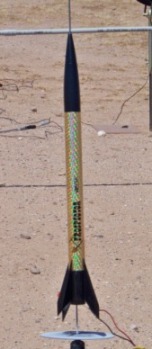| Construction Rating: | starstarstarstarstar_border |
| Flight Rating: | starstarstarstarstar_border |
| Overall Rating: | starstarstarstarstar_border |
| Published: | 2010-12-12 |
| Manufacturer: | Estes  |
Brief:
This is a basic single stage, four fin, plastic nosecone rocket. It is a ready to fly kit with minimal assembly which is to attach the parachute and you're done. A pretty basic rocket using standard B and C 18mm rocket engines. Estes item/kit number 002457.
Construction:
The rocket out of the box has two tubes that go together at a coupler joint which is also the separation point for the parachute ejection. The upper tube is 4.25 inches long without the nosecone or coupling. The lower tube is 8.5 inches long without the plastic fin can. The nosecone is glued into the top of the upper tube, and the fin can is glued onto the bottom of the lower tube. The shock cord is the standard Estes rubber band material. The nosecone is plastic as well as the fin can. The tube is wrapped in a gold prismatic type wrap. It uses a plastic cap to hold the engine in the rocket, the same as the Estes Chrome Dome, Metalizer, etc. The rocket has minimal parts.
Since this is a Ready To Fly rocket, there is no assembly required, The only assembly the rocket has would be to attach the parachute shroud lines to the rocket's shock cord since there is no nosecone to attach it to. The nosecone is already glued onto the top of the upper tube by the factory and is not accessible to attach a parachute. On my rocket, I used a simple 3 inch long rubber band to attach a fishing snap swivel to the shock cord, and the parachute shroud lines are connected to the snap part of the swivel. I feel it pays for itself in less tangles and twisted up parachute lines. The instructions were short because there is no construction, only attaching the parachute to the rocket. I thought they were fine. The only modification I made was to use a fishing snap swivel that I bought in Wal-Mart, but they are available in any store that sells fishing supplies.
 Finishing:
Finishing:
No finishing was required since the body tubes are in a gold wrap. There was one problem, the wrap started to unravel on my rocket and I had to use a bit of epoxy glue to fasten it back down so it wouldn't unravel the rest of the way. So far it has held with no problems. I've heard that using super glue on the wrap causes the color to come off, but I can't verify that. That's why I used epoxy. You could probably use contact cement with no problem.
Construction Rating: 4 out of 5
Flight:
So far it's flown nicely. The flights have been straight. On the first flight, the parachute got tangled around the rocket's fins so it landed a bit harder, and had no damage. The next two flights were great. They were straight with a nice parachute ejection at apogee. I think the plastic fins take a lot of punishment without being damaged. I'm not saying that they can't be damaged, but they are a robust or solid design. I've used B6-4 motors so far. I would have tried a C motor but the wind was stronger that day when I flew it for the second and third flights and I wanted to keep the flights lower.
Recovery:
I've heard from some people that the plastic engine retainer cap may slightly deform from the engine exhaust heat if C engines are used. There is no damage from the B engines; the cap did get very slightly pitted from the exhaust. I have an Estes Metalizer that has the same cap. It slightly deformed on one flight using a C engine, but never again on the other flights using C engines, and I'm still using it with no problems. Maybe it was a bad engine for that one flight? The Prospector did have straight flights whenever I've flown it. The parachute descent was a little faster than the other rockets I have, but I had no problems. I guess if you wanted to slow it down you could use a 15 inch nylon one. The rocket body tube is big enough to accommodate the nylon parachute if you choose to change it. I haven't had any damage so far in the three flights with the nosecone hitting the body tube during the parachute ejection. That's a good thing since you can't access the bottom of the nosecone to extend the shock cord because the upper body tube is glued to it by the factory.
Flight Rating: 4 out of 5
Summary:
I feel it's a good rocket overall. I would have liked to extend the shock cord, but it seems to be doing all right the way it is. It appears to come down just a little bit faster than my other rockets with the 12 inch parachute, but it has no damage either. I would recommend adding the fishing snap swivel using a 3 inch rubber band. The rocket flies straight, and there is lots of room to pack the shock cord and parachute in the body tube.
Overall Rating: 4 out of 5
Other:
I like the color and it looks nice. It also is a nice big rocket, taller than the Chrome Dome and HiJinks/Rascal rockets. So far in the last three flights it has performed well, only the parachute got tangled on the fins during the first flight, and it landed with no damage anyway. The next two flights were straight with no problems and had soft parachute landings. It still looks like the day I took it out of the box - in excellent condition. I'll be flying it more often.
 |
 |
Flights
 |
 |